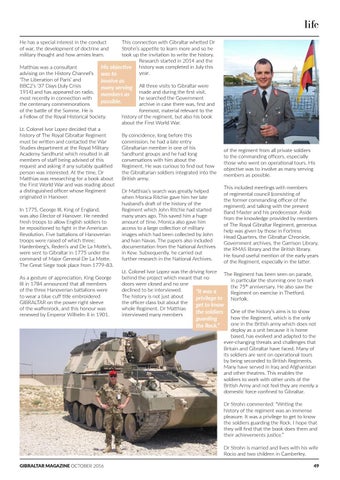life He has a special interest in the conduct of war, the development of doctrine and military thought and how armies learn.
This connection with Gibraltar whetted Dr Strohn’s appetite to learn more and so he took up the invitation to write the history. Research started in 2014 and the His objective history was completed in July this year. was to
Matthias was a consultant advising on the History Channel’s ‘The Liberation of Paris’ and involve as BBC2’s ‘37 Days (July Crisis many serving All three visits to Gibraltar were 1914) and has appeared on radio, made and during the first visit, members as most recently in connection with he searched the Government possible. the centenary commemorations archive in case there was, first and of the battle of the Somme. He is foremost, material relevant to the a Fellow of the Royal Historical Society. history of the regiment, but also his book about the First World War. Lt. Colonel Ivor Lopez decided that a history of The Royal Gibraltar Regiment By coincidence, long before this must be written and contacted the War commission, he had a late entry Studies department at the Royal Military Gibraltarian member in one of his of the regiment from all private soldiers Academy Sandhurst which resulted in all Sandhurst groups and he had long to the commanding officers, especially members of staff being advised of this conversations with him about the those who went on operational tours. His request and asking if any suitably qualified Regiment. He was curious to find out how objective was to involve as many serving person was interested. At the time, Dr the Gibraltarian soldiers integrated into the members as possible. Matthias was researching for a book about British army. the First World War and was reading about This included meetings with members a distinguished officer whose Regiment Dr Matthias’s search was greatly helped of regimental council (consisting of originated in Hanover. when Monica Ritchie gave him her late the former commanding officer of the husband’s draft of the history of the regiment), and talking with the present In 1775, George III, King of England, Regiment which John Ritchie had started Band Master and his predecessor. Aside was also Elector of Hanover. He needed many years ago. This saved him a huge from the knowledge provided by members fresh troops to allow English soldiers to amount of time. Monica also gave him of The Royal Gibraltar Regiment, generous be repositioned to fight in the American access to a large collection of military help was given by those in Fortress Revolution. Five battalions of Hanoverian images which had been collected by John Head Quarters, the Gibraltar Chronicle, troops were raised of which three; and Ivan Navas. The papers also included Government archives, the Garrison Library, Hardenberg’s, Reden’s and De La Motte’s, documentation from the National Archives the RMAS library and the British library. were sent to Gibraltar in 1775 under the in Kew. Subsequently, he carried out He found useful mention of the early years command of Major General De La Motte. further research in the National Archives. of the Regiment, especially in the latter. The Great Siege took place from 1779-83. Lt. Colonel Ivor Lopez was the driving force The Regiment has been seen on parade, As a gesture of appreciation, King George behind the project which meant that no in particular the stunning one to mark III in 1784 announced that all members doors were closed and no one the 75th anniversary. He also saw the of the three Hanoverian battalions were declined to be interviewed. “It was a Regiment on exercise in Thetford, to wear a blue cuff title embroidered The history is not just about privilege to Norfolk. GIBRALTAR on the power right sleeve the officer class but about the get to know of the waffenrock, and this honour was whole Regiment. Dr Matthias the soldiers One of the history’s aims is to show renewed by Emperor Wilhelm II in 1901. interviewed many members how the Regiment, which is the only guarding one in the British army which does not the Rock.” deploy as a unit because it is home based, has evolved and adapted to the ever-changing threats and challenges that Britain and Gibraltar have faced. Many of its soldiers are sent on operational tours by being seconded to British Regiments. Many have served in Iraq and Afghanistan and other theatres. This enables the soldiers to work with other units of the British Army and not feel they are merely a domestic force confined to Gibraltar. Dr Strohn commented: “Writing the history of the regiment was an immense pleasure. It was a privilege to get to know the soldiers guarding the Rock. I hope that they will find that the book does them and their achievements justice.” Dr Strohn is married and lives with his wife Rocio and two children in Camberley. GIBRALTAR MAGAZINE OCTOBER 2016
49
